The rise of open innovation has been a long-standing trend in business. In the early 1990s, companies were starting to realize that they could improve their competitive edge by sharing their ideas and innovations with others. This led to the development of the concept of “open source” software, which allows for free exchange of information among developers. Open innovation is a term first coined by professor Henry Chesbrough in his 2003 book “Open Innovation: The New Imperative for Creating and Profiting from Technology”. It describes the process of organizations leveraging external ideas and resources to drive innovation and growth. This can be done through things like open R&D, corporate venturing, collaborative research, etc.
Henry Chesbrough’s work on open innovation has had a significant impact on the field over the past two decades, helping to shape a more open and collaborative approach to innovation. His work has shown that organisations can benefit from sharing ideas and knowledge with others, rather than keeping them secret. Open innovation can help organisations to be more agile and responsive to change, as well as reducing costs associated with research and development. Now recognised by companies of all sizes, in all industries – Henry Chesbrough’s work on open innovation is an important part of the 21st century way of doing business. Open innovation has been shown to be an effective way for companies to accelerate the pace of innovation and bring new products and services to market faster. Many leading companies like Google, Apple, 3M, etc. have all adopted open innovation practices with great success.
Over the past 20 years, there has been a significant increase in the number of scientific publications on open innovation. This growth is indicative of the evolving nature of open innovation, as it becomes more widely adopted by organizations across different industries. As open innovation continues to evolve, we can expect to see even more innovative applications and results achieved through its implementation. The benefits of open innovation are numerous and well-documented, making it an attractive option for organizations looking to improve their R&D efficiency and effectiveness. There are a variety of ways to implement open innovation, so organizations should carefully consider which approach is best suited for their needs and objectives.
Infographic: a visualization of 20 years of Open Innovation research
To celebrate the fact that 20 years have passed since Chesbrough’s seminal work in open innovation in 2003, we’ve created a stunning infographic that highlights trends and developments in open innovation research over the years. The infographic contains the following detailed information:
- Most influential authors on open innovation
- Most influential publications on open innovation
- Most influential upcoming publications on open innovation
- Most influential trends in open innovation research
- Most influential journals on open innovation
The methodology leading up to the data visuals are described below.
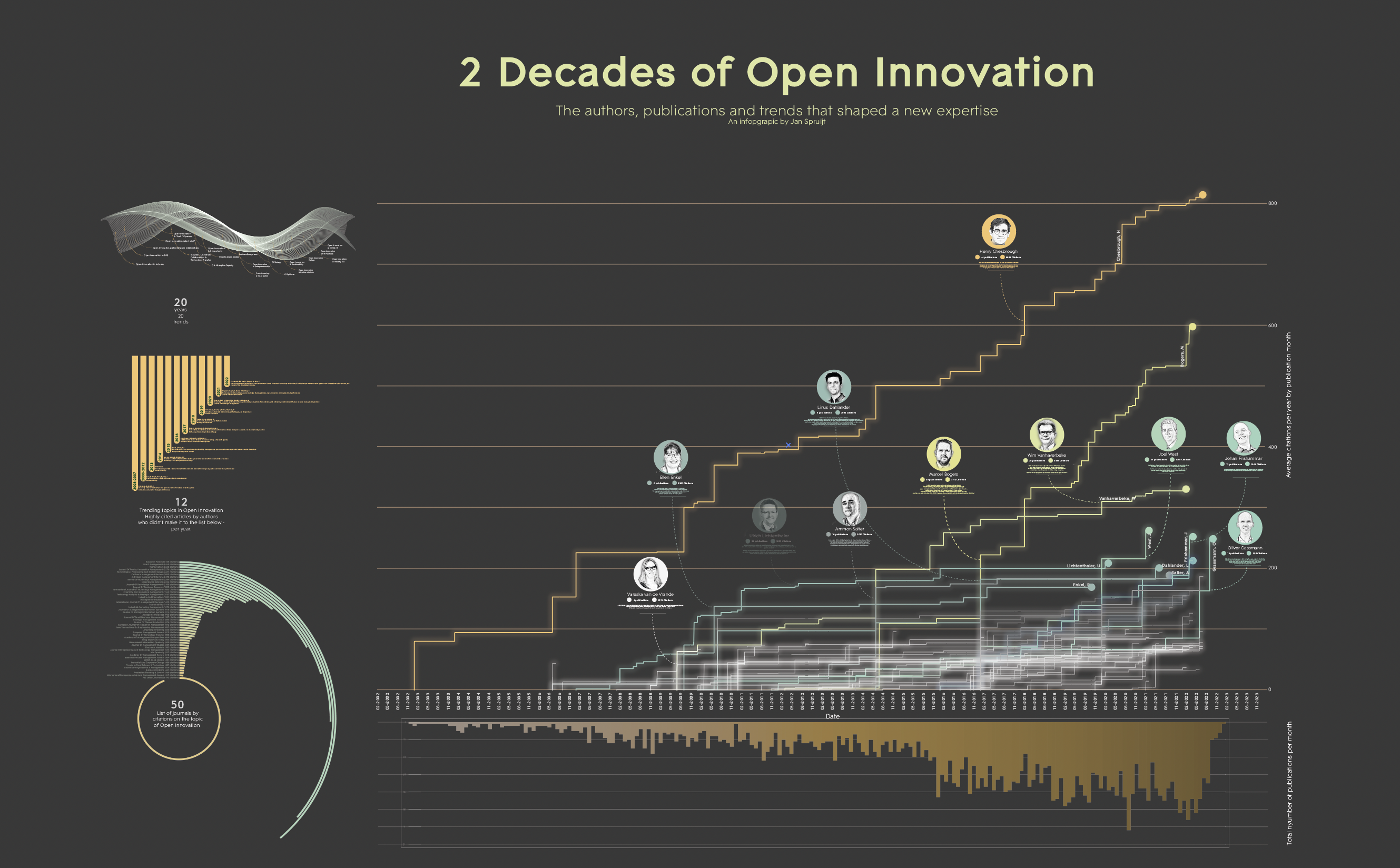
This infographic is part of the book Innographics: A Visual Guide to Innovation Management
Download a 32-page preview for free
Including 2 infographics, 2 chapters and an overview of 28 innographics.
☑ I agree with opting in for the newsletter, our terms and privacy policy.
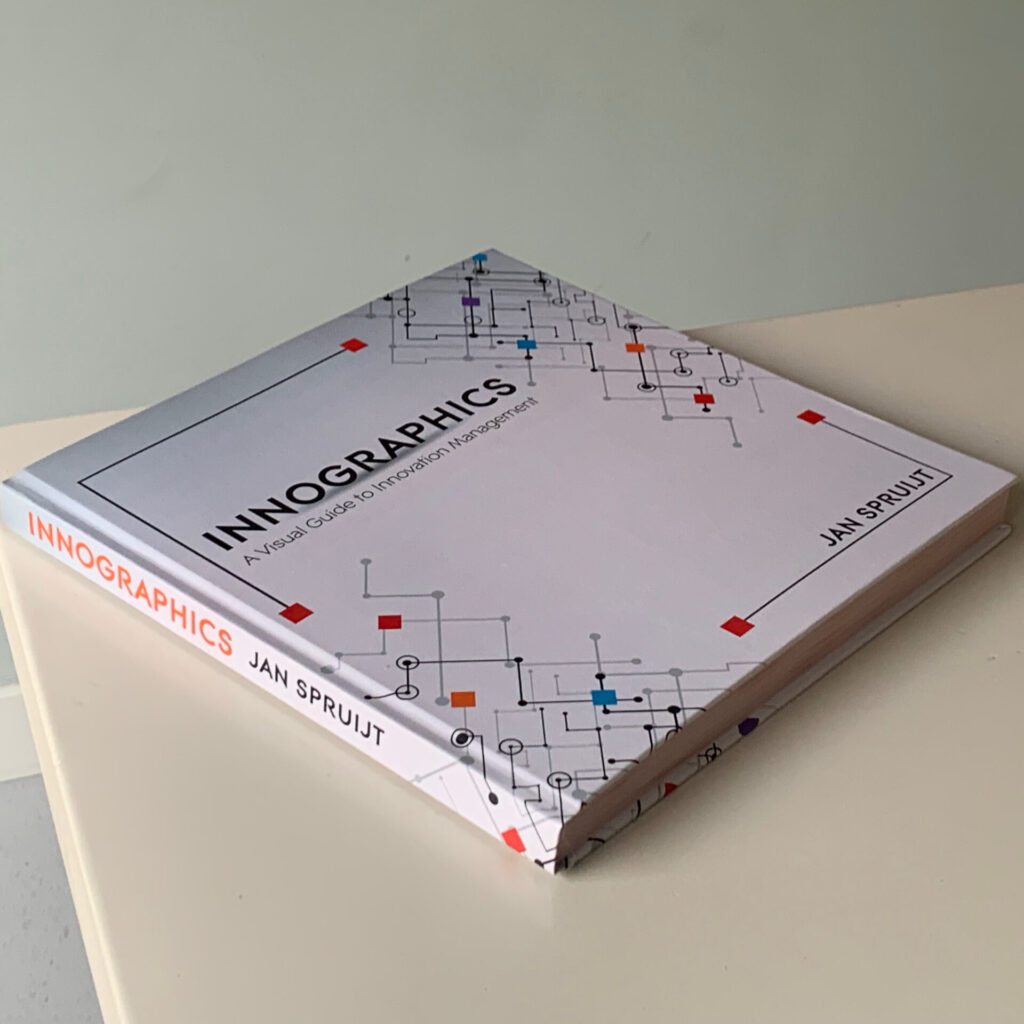
Methodology
In order to create this overview of open innovation, we’ve searched through scientific publications on open innovation. For this purpose, in line with other publications in the field, we’ve searched through the Web of Science with the simple search term: TS=(“Open Innovation”). TS is a search operator that makes sure that only the title, abstract and keywords of an article are taken into consideration. This resulted in exactly 3886 publication published between 2003 and 2023 (early access papers might contain a publication date in the near future). However, Web of Science also sometimes includes so-called predatory journals – journals that do not meet the quality standards. We’ve ignored publications and authors that have primarily published in predatory journals. We’ve used this as our basis for creating the visualization:
- Most influential authors on open innovation:
- In total there were 2456 different scholars who contributed to 1 or more publications in the field of open innovation. To define which scholars are among the most influential ones we used three different methods:
1) we looked at the total number of citations on open innovation that each author has received through publications that are in our list. This way we found that Chesbrough received 8889 citations, followed by West (3777), Vanhaverbeke (3531), Bogers (3146), Enkel (3134), Lichtenthaler (2825), Gassmann (2787) and Dahlander (2052).
2) we looked at the total number of publications on open innovation that each author has publihsed. The results: Chesbrough (45), Bogers (41), Lichtenthaler (37), Vanhaverbeke (27), Frattini (26), Santoro (24), Di Minin (22), Grimaldi (20), Ferreira (20), Lazzarotti (18) etc.
3) last, we looked at the average citations per publication. This way we could also find upcoming authors who have a shorter track record than the authors above. The results: Rochemont (1090), Brescia (843), Crowther (497), Gretzel (424), Perkmann (423), Dahlander (410), Gann (379), De Jong (377) etc. - If an author met the following at least 2 of the following conditions, it was included in our visual: >500 citations, >5 publications and/or >75 citations/publication. As a result we included 75 authors in our visual.
We’ve then included all of the papers of each of these authors in our visual and used its average citation/year number to indicate it’s importance. By doing so, our visual does not only include the most influential authors since 2003, but also upcoming authors with a shorter track record. This is an example of how we included the 45 publications of Chesbrough in our graph:
- In total there were 2456 different scholars who contributed to 1 or more publications in the field of open innovation. To define which scholars are among the most influential ones we used three different methods:
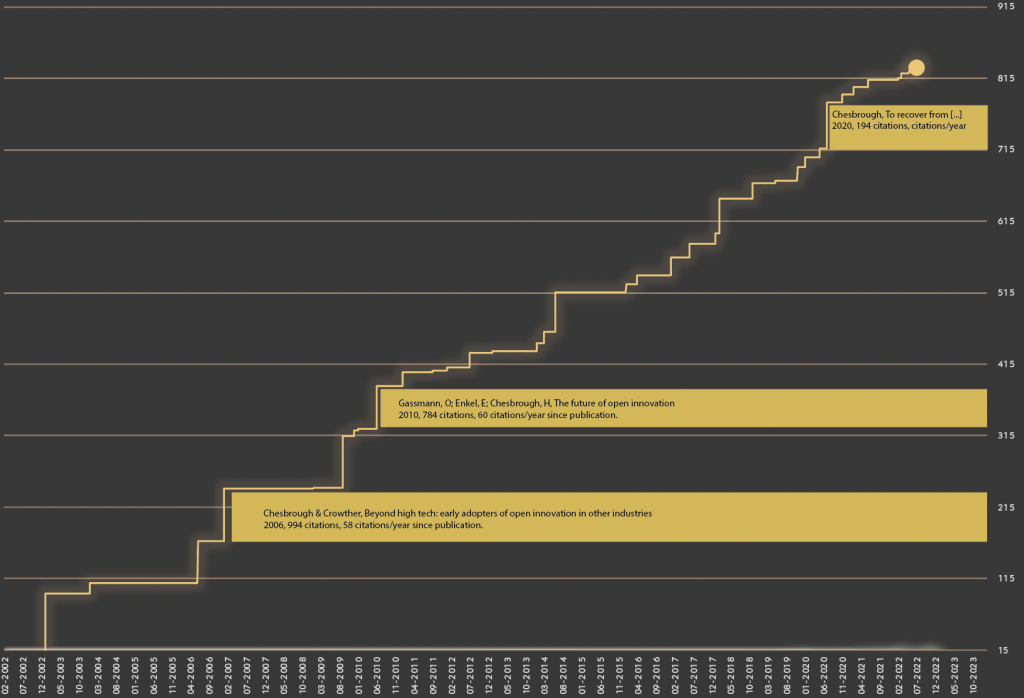
- Most influential publications on open innovation:
- Not only did we look at the most influential authors, we also looked at the most influential papers. This resulted in the following list:
Chesbrough, HW; The era of open innovation; Mit Sloan Management Review. - Dahlander, L; Gann, DM; How open is innovation?; Research Policy.
- Van de Vrande, V; de Jong, JPJ; Vanhaverbeke, W; de Rochemont, M; Open innovation in SMEs: Trends, motives and management challenges; Technovation.
- Enkel, E; Gassmann, O; Chesbrough, H; Open R&D and open innovation: exploring the phenomenon; R & D Management.
- Chesbrough, H; Crowther, AK; Beyond high tech: early adopters of open innovation in other industries; R & D Management.
- Huizingh, EKRE; Open innovation: State of the art and future perspectives; Technovation.
- West, J; Bogers, M; Leveraging External Sources of Innovation: A Review of Research on Open Innovation; Journal Of Product Innovation Management.
- Gassmann, O; Enkel, E; Chesbrough, H; The future of open innovation; R & D Management.
- Perkmann, M; Walsh, K; University-industry relationships and open innovation: Towards a research agenda; International Journal Of Management Reviews.
- Lee, S; Park, G; Yoon, B; Park, J; Open innovation in SMEs-An intermediated network model; Research Policy.
- Cooper, RG; Perspective: The Stage-Gate (R) idea-to-launch process-update, what’s new, and NexGen systems; Journal Of Product Innovation Management.
- Jeppesen, LB; Lakhani, KR; Marginality and Problem-Solving Effectiveness in Broadcast Search; Organization Science.
- Gretzel, U; Sigala, M; Xiang, Z; Koo, C; Smart tourism: foundations and developments; Electronic Markets.
- Chesbrough, HW; Appleyard, MM; Open innovation and strategy; California Management Review.
- Baldwin, C; von Hippel, E; Modeling a Paradigm Shift: From Producer Innovation to User and Open Collaborative Innovation; Organization Science.
- Laursen, K; Salter, AJ; The paradox of openness: Appropriability, external search and collaboration; Research Policy.
- West, J; Gallagher, S; Challenges of open innovation: the paradox of firm investment in open-source software; R & D Management.
- Lichtenthaler, U; Lichtenthaler, E; A Capability-Based Framework for Open Innovation: Complementing Absorptive Capacity; Journal Of Management Studies.
- West, J; Salter, A; Vanhaverbeke, W; Chesbrough, H; Open innovation: The next decade Introduction; Research Policy.
- Terwiesch, C; Xu, Y; Innovation contests, open innovation, and multiagent problem solving; Management Science.
- Chesbrough, H; The logic of open innovation: Managing intellectual property; California Management Review.
- Bogers, M et al.; The open innovation research landscape: established perspectives and emerging themes across different levels of analysis; Industry And Innovation.
- Parida, V; Westerberg, M; Frishammar, J; Inbound Open Innovation Activities in High-Tech SMEs: The Impact on Innovation Performance; Journal Of Small Business Management.
- Not only did we look at the most influential authors, we also looked at the most influential papers. This resulted in the following list:
- Most influential upcoming authors on open innovation:
- We’ve also created a list of upcoming authors and their publications. For this, we simply used the mechanism that we selected the most cited papers per year of which the leading author was not selected under 1) or 2).
- Most influential trends on open innovation.
- For this, we’ve analyzed all keywords associated with all papers and looked for patterns. We’ve then cross-checked these quick-and-dirty patterns with several peer-reviewed bibliometric reviews in the field of open innovation to be able to distinguish the trends on open innovation.
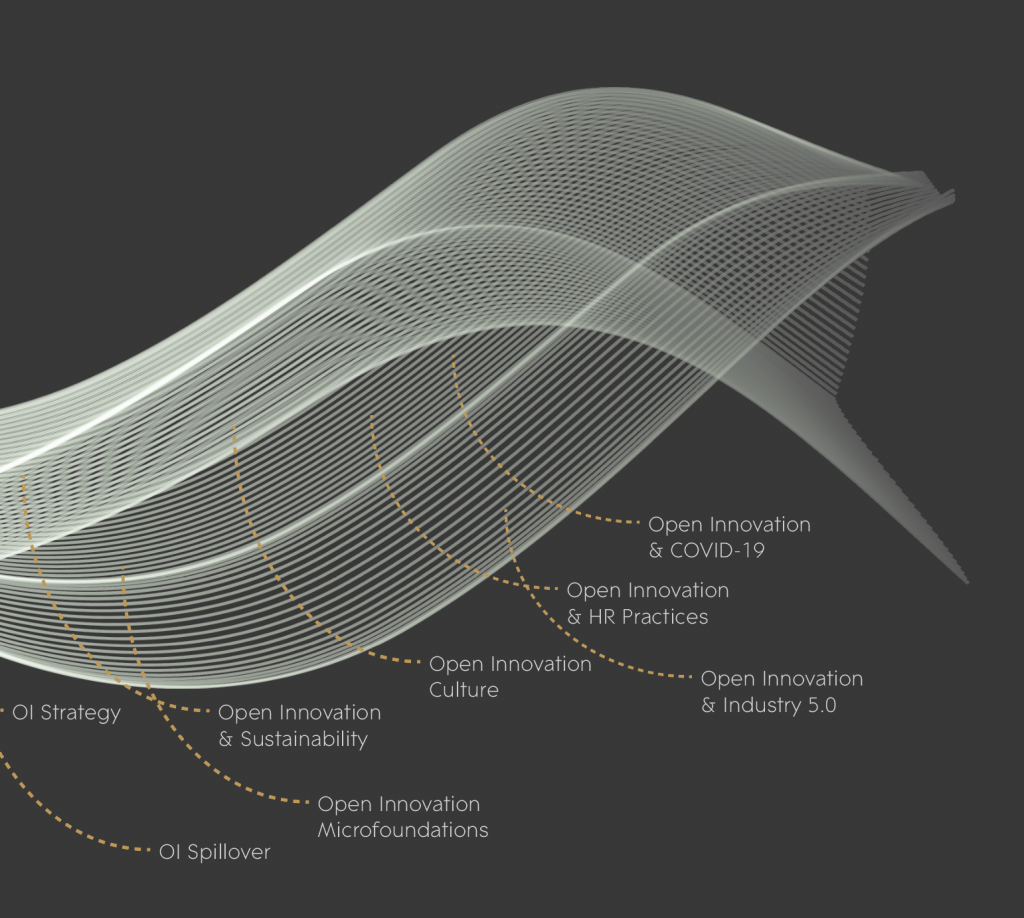
- Most influential journals on open innovation.
- We’ve simply calculated the total number of citations per journal.
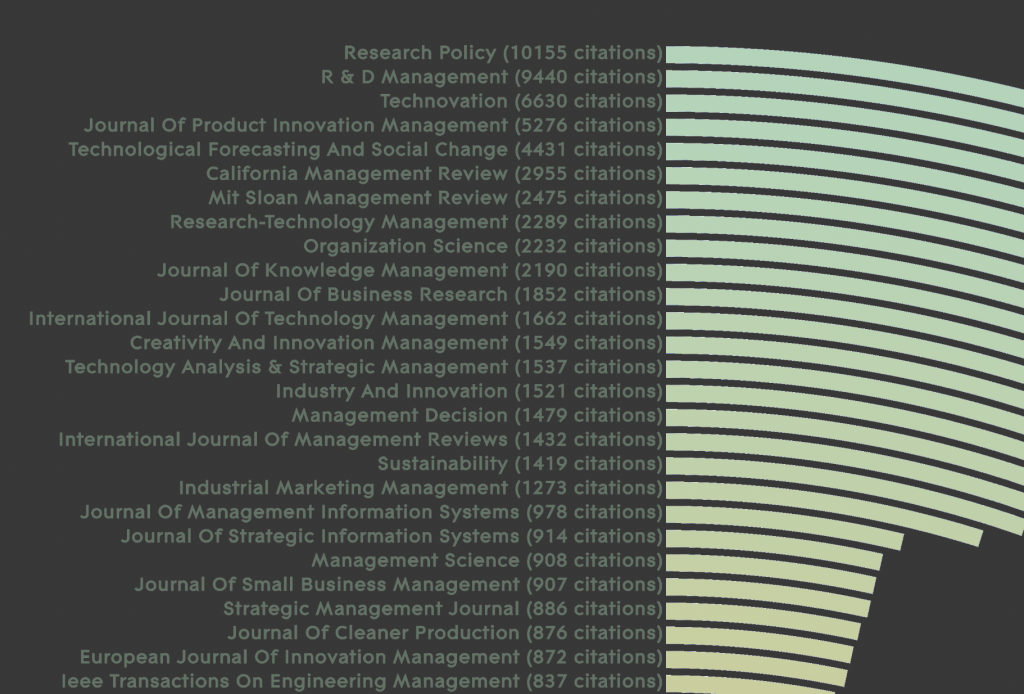
Limitations
We are aware of the fact that this infographic knows a few limitations:
- We’ve only used the Web of Science database, which might exclude journals indexed by other databased.
- We’ve only searched for “Open Innovation” and not for common related terms such as “collaborative innovation”, “ecosystems of innovation” and so on.
- We’ve only included scientific publications, while the authors in this list – but also several authors outside of this list – have published more popular books on open innovation – which are not included in this review.
- We’ve only included scholars, whereas field practitioners might have had a severe influence on the success of open innovation as well.
- We’ve excluded retracted papers, but still included authors that have had retracted papers, such as Lichtenthaler (because of inconsistencies in his research methodology).
- We’ve based our conclusions on the number of citations indexed by Web of Science only (resulting in the fact that the actual number of publications and citations for each author might be different).
The future of open innovation looks promising – as evidenced by the continued growth of open source software and other forms of collaborative technology (such as social networks). Furthermore, new technologies such as artificial intelligence (AI) may further enhance the benefits associated with open innovation platforms.